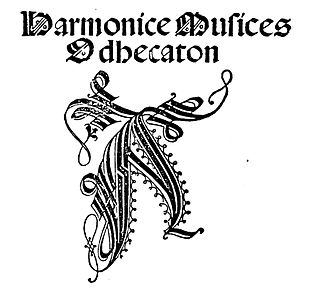Ottaviano Petrucci was an Italian printer. His Harmonice Musices Odhecaton, a collection of chansons printed in 1501, is commonly misidentified as the first book of sheet music printed from movable type. Actually that distinction belongs to the Roman printer Ulrich Han's Missale Romanum of 1476. Nevertheless, Petrucci's later work was extraordinary for the complexity of his white mensural notation and the smallness of his font, and he did in fact print the first book of polyphony using movable type. He also published numerous works by the most highly regarded composers of the Renaissance, including Josquin des Prez and Antoine Brumel.
The designation Franco-Flemish School, also called Netherlandish School, Burgundian School, Low Countries School, Flemish School, Dutch School, or Northern School, refers to the style of polyphonic vocal music composition originating from France and from the Burgundian Netherlands in the 15th and 16th centuries as well as to the composers who wrote it. The spread of their technique, especially after the revolutionary development of printing, produced the first true international style since the unification of Gregorian chant in the 9th century. Franco-Flemish composers mainly wrote sacred music, primarily masses, motets, and hymns.
Antoine Brumel was a French composer. He was one of the first renowned French members of the Franco-Flemish school of the Renaissance, and, after Josquin des Prez, was one of the most influential composers of his generation.
Jean L'Héritier was a French composer of the Renaissance. He was mainly famous as a composer of motets, and is representative of the generation of composers active in the early to middle 16th century who anticipated the style of Palestrina.

The Harmonice Musices Odhecaton is an anthology of polyphonic secular songs published by Ottaviano Petrucci in 1501 in Venice. It is the first book of polyphonic music ever to be printed using movable type. The Odhecaton was hugely influential both in publishing in general and in dissemination of the Franco-Flemish musical style.
Antoine de Longueval was a French singer and composer of the Renaissance. A contemporary of Josquin des Prez, he was singing master of the French royal chapel under King Francis I, and was important in the history of the polyphonic setting of the Passion.

Andrea Antico was a music printer, editor, publisher and composer of the Renaissance born in the Republic of Venice, of Istrian birth, active in Rome and in Venice. He was the first printer of sacred music in Rome, and the earliest competitor of Venetian Ottaviano Petrucci, who is regarded as the first significant music printer.

The Missa L'homme armé super voces musicales is the first of two settings of the Ordinary of the Mass by Josquin des Prez using the famous L'homme armé tune as his cantus firmus source material. The setting is for four voices. It was the most famous mass Josquin composed, surviving in numerous manuscripts and print editions. The earliest printed collection of music devoted to a single composer, the Misse Josquin published by Ottaviano Petrucci in 1502, begins with this famous work.

The Missa de Beata Virgine is a musical setting of the Ordinary of the Mass, by Renaissance composer Josquin des Prez. Though formerly believed to have been a late composition due to stylistic reasons, evidence from Burchard’s Diary proves that the mass was written sometime before September 23, 1497. It was the most popular of his masses in the 16th century.
This is a list of notable events in music that took place in the 1490s.
The decade of the 1510s in music involved some significant events.

Francesco Spinacino was an Italian lutenist and composer. His surviving output comprises the first two volumes of Ottaviano Petrucci's influential series of lute music publications: Intabolatura de lauto libro primo and Intabolatura de lauto libro secondo. These two collections comprise the first known printed lute music, and his first book was the first ever instrumental music book printed with the movable type system.
Giovanni Maria Alemanni was an Italian composer and lutenist. Practically nothing is known about his life or work. The only known collection of his music, published in 1508 by Ottaviano Petrucci, is lost. He was still active in 1521, and apparently was one of the last exponents of the plectrum technique. Alemanni's reputation was probably quite high: in 1536 the printer Francesco Marcolini praised him as one of the best composers of his time, along with Giovanni Angelo Testagrossa and Josquin des Prez.
Fridolin Sicher was a Swiss composer and organist of the Renaissance. He was born in Bischofszell and began his study of the organ at the age of 13 with Martin Vogelmaier, the organist of Konstanz Cathedral. He then studied theology and in 1510 became a prebend and organist at St Agnes Church in Bischofszell. He later returned to Konstanz for further study with Hans Buchner. Sicher went on to become the organist of the collegiate church of St Gallen and of St Michael's Church in Ensisheim. He returned to Bischofszell in 1537, where he was made both organist and chaplain of St Agnes Church.
This is a list of notable events in music that took place in the 1470s.





